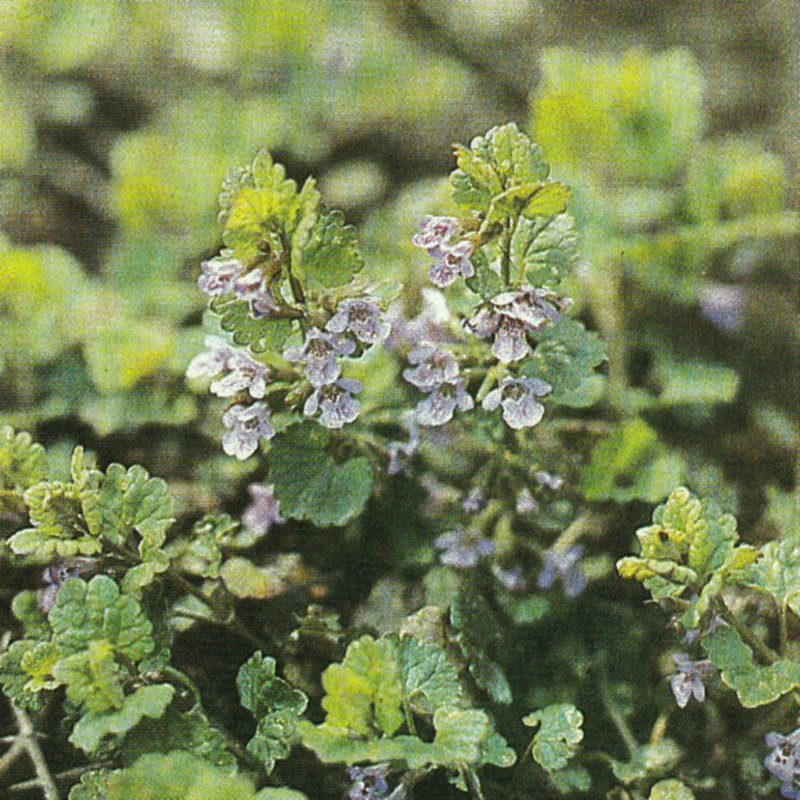Botanical name
Glechoma hederacea L.
Family
Lamiaceae
Common name
Ground-ivy, Gill-over-the-ground, Creeping Charlie, Tunhoof, Field balm
Information about the plant
Ground ivy is a perennial plant widely distributed across Central and Northern Europe, the Caucasus region, and Western Siberia. It has been naturalized in North America. In Central Europe, it often grows in hedgerows, along walls, in damp meadows, sparse forests, and at the edges of woodlands and thickets up to altitudes of 1500 meters. It is an important plant in Central Europe as a bee pasture.
The genus name Glechoma derives from the Greek ‘glechon’, which is the Greek name for pennyroyal (Mentha pulegium L.), possibly due to its resemblance to ground ivy. The species epithet hederacea refers to the leaves of ground ivy, which are very similar to the foliage of ivy, also a wintergreen plant (Hedera = ivy, Latin ‘hederaceus’ = ivy-like). Ground ivy ‘clings to the ground with its creeping stems rooting at the lower nodes, like the vine to the trunk and wall’. This behavior shows the similarity to ivy, which also clings to walls, and explains the connection to the German name ‘Gundelrebe’. This comes from the Old High German ‘grund(e)rӗba’, which evolved via Middle High German ‘grunderӗbe’ into Modern High German ‘Gundelrebe’. In the 12th century, the plant's name was transformed into the male name Gundram and changed to Gundermann. Both names - Gundelrebe and Gundermann - are still commonly used in Germany.
Ground ivy is a wintergreen, perennial plant 5 to 20 cm tall, with ascending and creeping stems rooting at the nodes, almost glabrous to densely hairy. After flowering, it produces stolons over 1 meter long. The leaves are kidney- to heart-shaped, with coarsely, bluntly-toothed margins. The flowers are axillary in pseudo-whorls (2 to 6 flowers); the calyx is often purple; the blue-violet (rarely white) corolla is 1 to 2 cm long, with a notched upper lip and a slightly longer, clearly three-lobed lower lip. Ground ivy is considered toxic to animals, especially horses. The flowering time is from March to May.
Medicinally used parts of plants (herbal drug)
The dried aerial parts, consisting of stems, leaves, and flowers, are used (ground ivy herb - Glechomae herba).
The commercially available drug is sourced from Eastern European countries (wild collection).
Constituents of the herbal drug
Ground ivy herb contains essential oil, lamiaceous tannins, flavonoids, triterpene carboxylic acids, and traces of alkaloids.
Quality of the drug
The quality of ground ivy herb (Glechomae herba) is specified in the German Drug Codex (DAC).
Medical applications
Recognised medical use
Ground ivy herb has not been evaluated by the HMPC or the ESCOP.
Ground ivy herb is used in folk medicine for mild colds and coughs, as well as for gastrointestinal complaints. Externally, it is used in the form of baths for skin diseases.
Traditional use
Registration of an alcoholic extract of ground ivy herb (DER 2:1) as a traditional medicinal product with the indication ‘to improve the condition in mild biliary complaints such as bloating and flatulence in known gallstones not requiring surgery’.
Herbal drug preparations in finished dosage forms
- Ground ivy herb as tea
- Alcoholic extract (DER 2:1)
- Fluid extract
- Glechoma hederacea mother tincture
Dosage
Finished medicinal products and finished preparations: See patient information leaflet or instructions for use.
Tea: Drink 1 cup of freshly prepared ground ivy tea, warm, 2 to 4 times a day.
Preparation of a tea
Pour 150 ml of boiling water over 2 to 4 g of finely chopped ground ivy herb, stand for 5 minutes and strain.
Notes
Ground ivy herb is mainly used in folk medicine. Detailed data on its effects and adverse effects are not available. It is, therefore, not recommended for use during pregnancy or lactation, or in children and adolescents under the age of 18.
Side effects
High doses can lead to gastrointestinal catarrh and intestinal colic.
Interactions
None known.


